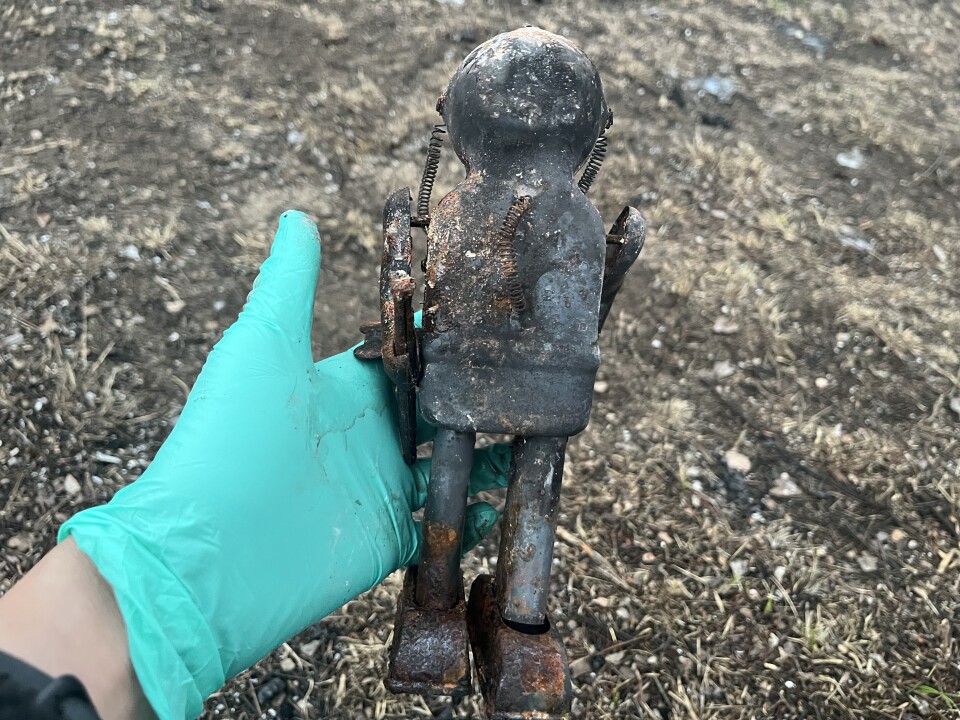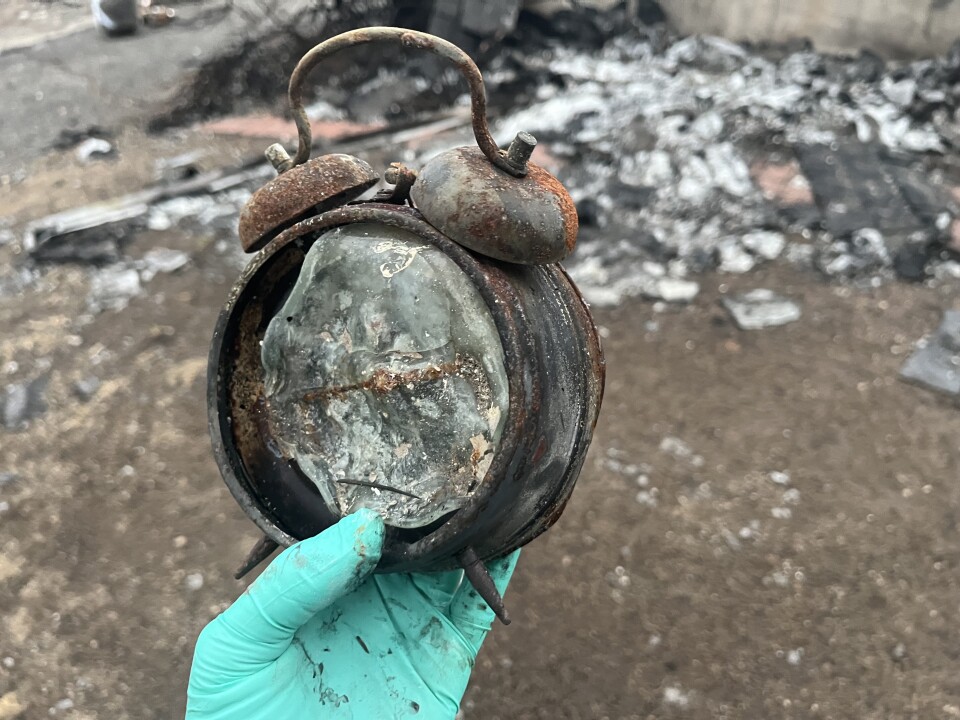Truth matters. Community matters. Your support makes both possible. LAist is one of the few places where news remains independent and free from political and corporate influence. Stand up for truth and for LAist. Make your year-end tax-deductible gift now.
I thought my family keepsakes were gone after the fire. Then I found these volunteers

To sift or not to sift? That’s a question a lot of us who lost homes in the Los Angeles fires have been asking ourselves and each other.
In the quiet moments after these infernos, you’re jolted into remembering what is gone: keepsakes that marked a time in your life, things made by the people you love, belongings of loved ones no longer with you.
At the same time, the thought of digging through rubble seems so overwhelming. What if you find nothing, or nothing salvageable? What about all the toxins?
Amid these competing thoughts, I found myself at my burnt-out home in Altadena earlier this week. Joining me were 10 church volunteers armed with shovels and sifters recruited through Samaritan’s Purse, a Christian disaster relief organization.

Led by evangelist Franklin Graham, Samaritan's Purse has developed a niche helping people recover personal items from disaster zones across the country. Over the last two decades, it’s spent increasing time in California assisting those displaced by fires coming at an intensifying pace because of the climate crisis.
Leading the team at my property for three hours is Nancy Valentine, a retired ophthalmologic technician from Albuquerque, N.M. who spends months of the year volunteering with Samaritan’s Purse.
“This is our joy and privilege to come alongside you in a really difficult, difficult time,” Valentine said.
By its count, Samaritan’s Purse has assisted more than 200 households in Altadena out of 1,000-plus that have requested help from across L.A. County. The group says they are still waiting for the green light from L.A. officials so volunteers can enter Pacific Palisades, where access remains restricted.
Like a tornado
I learned about the nonprofit through my mother-in-law who, while on a flight out to Los Angeles to help us after the fire, struck up a rapport with another passenger who works with Samaritan’s Purse.
I'd been feeling pressure to decide whether to search the remains of my home, given the push by federal and state officials to speedily clean up burn areas. Afterward, government or private contractors would come in with excavators.
So when a volunteer from Samaritan's Purse called, we set a date to meet up this week.

First order of business for Valentine was to map out the house. She asks where the front door.
I point to the concrete steps leading up to an entrance that is no more. But I’m disoriented by the lack of interior walls. It takes a moment for me to realize the dishwasher is now sitting in the living room.
“You know, things move,” Valentine said. “Fire creates a tornadic kind of thing lots of times in structures. The other day, we found china on the opposite side of the house of where the china hutch was, and some plates were still intact. Go figure.”
Across burn areas, word about Samaritan’s Purse name is spreading through word of mouth and churches.
I’ve asked people working for county agencies to recommend groups that salvage valuables and have come up empty. No other group seems as focused on this work as Samaritan’s Purse and certainly not at this scale.
Since the fires, nearly 600 people have volunteered with the group, mostly through their churches in Southern California. The volunteers convened at my house are one of several teams dispatched across Altadena that day, most of them hailing from Los Angeles, Riverside and Orange counties, along with two women from Massachusetts and Minnesota.
Everybody is suited up in Tyvek coveralls, goggles and respirators, including myself. Valentine kicks off the day with prayer before everybody is dispatched to different sections of the house.
“Father, we want to be a blessing to Josie and her family,” Valentine says, head bowed.
A Hollywood beginning
Believe me when I say a prayer circle happening at the end of my driveway is not something I ever envisioned. Then again I never thought my house would burn down. Things got even more surreal when the leadership team from Samaritan’s Purse showed up. That included COO Edward Graham, trailed by a photographer and videographer.
Graham is the grandson of the late Billy Graham and the son of Franklin Graham, who runs Samaritan’s Purse out of North Carolina. It was founded, though, in California by Bob Pierce who had also started World Vision. Its offices were in Hollywood.

“And then when Dad took over back in the 70s, he moved it to Boone, North Carolina,” Graham said.
Graham says the non-profit first deployed to California in a major way more than 20 years ago as the Cedar Fire raged through San Diego County. The non-profit has since then built up a base in Fullerton, so they can provide meals and help with cleanup and rebuilding.
“We have semi-trucks, kitchen trailers and cook trailers that we have in one of our warehouses in Fullerton,” Graham said. “So we're spread out with equipment between here, Texas and back in North Carolina.”
You can see the white Samaritan’s Purse box vans all over Altadena and Pasadena. outfitted, I now know, with sledgehammers used to get at items buried under fallen walls. When that’s not enough to cut through the mesh and plaster, out came the power tools.
Finding treasures
Over by where our fireplace once was, Christina from Massachusetts was looking for any ceramics that might have survived. She’s retired from managing contracts in the aerospace industry. I ask her why she travels to do this painstaking work of sorting through detritus.
“Jesus commands us to go and do unto others and love your neighbor, and that's what we're doing,” she said. “We're hoping that this softens your heart and makes you like, ‘Wow, I want that'.”

As the volunteers’ shift wound down, they presented me with a Bible with their inscriptions and prayed again in a circle before departing for lunch, which would be followed by a visit to another home.
It moved me to no end to see complete strangers put so much effort into trying to make my family feel a little bit more whole again, and to see them treat my home with such care and respect even though it’s now grayish-brown piles of ash and rubble.
But in some of those piles are memories. The volunteers found a tin robot I bought in my 20s, its bright varnish now dulled by soot. A charred alarm clock has retained its familiar form but will never trill again. A tin box protected the Trivia Pursuit cards inside, intact but the questions faded away, likely from the passage of time.
I’ll admit I'd be disappointed if that’s all that was recovered. But a small ring that belonged to my mom was uncovered. Two tin Christmas angels my mother-in-law gave my husband made it too.

And I yelp with surprise when I’m presented with a figurine I think is made out of jade. It’s of an old man with a long beard and enormous forehead, holding in one palm the peach of immortality – a symbol of longevity in parts of Asia.
Valentine and I both marvel at its unmarred surface, the intricately carved lines still in sharp relief.
It will no doubt have a special spot in a permanent home that we’ll have again, one day.
How to return home after a fire
- Remember there may be toxic materials resting in the detritus of your home, so you run a health and safety risk sifting for personal items.
L.A. County's public health department recommends that people who decide to return to their homes wear household dishwashing gloves, a long-sleeved shirt, long pants and safety goggles.
A properly-fitting N-95 or P-100 mask is needed to protect exposure to ash and other airborne particles.
Also wear safety shoes or sturdy boots to protect yourself from nails, glass shards and splintered wood.
The county is giving out Tyvek suits, shoe covers, gloves and googles at disaster recovery centers.
Cleaning valuables
If you recover any keepsakes, note what kind of material it's made out of before you clean it.
For items made from more porous materials such a plaster or untreated wood, a dry chemical sponge is recommended to remove soot without pushing it deeper into the surface.
- For items with less porous surfaces such as tile, sealed wood, glass, vinyl and metal, the county public health department recommends using a sponge or towel with a household cleaning product.











